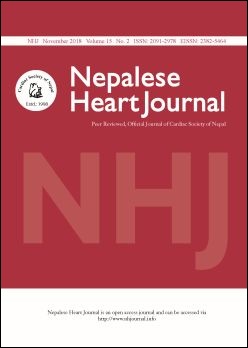Prevalence and patterns of coronary artery disease in patients undergoing cardiac surgery for rheumatic and non- rheumatic valvular heart disease in a tertiary care center of Nepal
DOI:
https://doi.org/10.3126/njh.v15i2.21472Keywords:
Bicuspid aortic valve, coronary artery disease, coronary angiography, degenerative valvular heart disease, mitral valve prolapse.Abstract
Background and Aims: Coronary artery disease (CAD) constitute a major cause of cardiovascular morbidity and mortality worldwide with an enormous burden on healthcare resources. Prevalence and pattern of CAD in patients of rheumatic and non-rhemuatic valvular heart diseases varies widely with limited data on optimal strategies for diagnosis and treatment.
Methods: This study includes 97 patients with rheumatic and non-rheumatic valvular heart disease who underwent coronary angiogram (CAG) before cardiac surgery. Patients were divided into two groups based on rheumatic heart disease (RHD) & non-rheumatic disease (Non-RHD) and correlate the patterns of CAD.
Results: Out of 97 patients, 22 (22.6%) patients were found to have significant CAD. In patients with non-rheumatic origin CAD was common (15 patients, 68.1%) as compared to rheumatic origin (7 patients, 31. 8%). In rheumatic origin, the prevalence was 7(12.2%) out of 57 patients while in non-rheumatic origin, was 15(37.5%) out of 40 patients. In RHD group, all patients with CAD were found to have single vessel diease (SVD) while, in non-RHD group, 11 patients (73.3%) had SVD, 3 patients (16.7%) had double vessel disease (DVD) and one patient (5.6%) had triple vessel disease (TVD).
Conclusions: Prevalence of CAD is higher in patients with non-RHD in comparison to those with RHD. We also found SVD to be the most common pattern of CAD in both rheumatic and non-rheumatic valvular heart disease.
Downloads
Downloads
Published
How to Cite
Issue
Section
License
This license enables reusers to distribute, remix, adapt, and build upon the material in any medium or format, so long as attribution is given to the creator. The license allows for commercial use.




